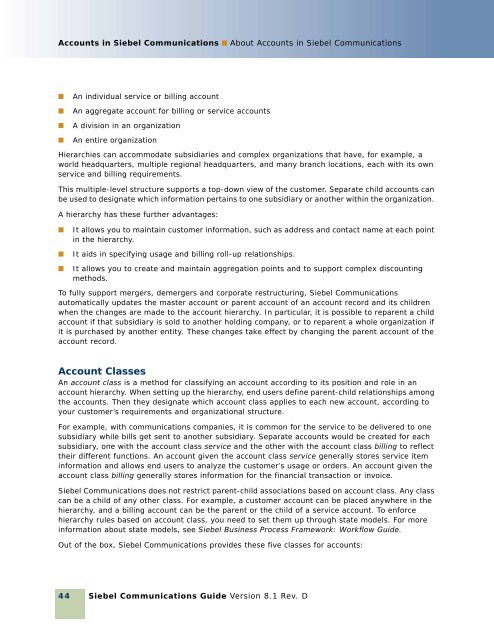Siebel Communications Guide - Downloads - Oracle
Siebel Communications Guide - Downloads - Oracle
Siebel Communications Guide - Downloads - Oracle
You also want an ePaper? Increase the reach of your titles
YUMPU automatically turns print PDFs into web optimized ePapers that Google loves.
Accounts in <strong>Siebel</strong> <strong>Communications</strong> ■ About Accounts in <strong>Siebel</strong> <strong>Communications</strong><br />
■ An individual service or billing account<br />
■ An aggregate account for billing or service accounts<br />
■ A division in an organization<br />
■ An entire organization<br />
Hierarchies can accommodate subsidiaries and complex organizations that have, for example, a<br />
world headquarters, multiple regional headquarters, and many branch locations, each with its own<br />
service and billing requirements.<br />
This multiple-level structure supports a top-down view of the customer. Separate child accounts can<br />
be used to designate which information pertains to one subsidiary or another within the organization.<br />
A hierarchy has these further advantages:<br />
■ It allows you to maintain customer information, such as address and contact name at each point<br />
in the hierarchy.<br />
■ It aids in specifying usage and billing roll-up relationships.<br />
■ It allows you to create and maintain aggregation points and to support complex discounting<br />
methods.<br />
To fully support mergers, demergers and corporate restructuring, <strong>Siebel</strong> <strong>Communications</strong><br />
automatically updates the master account or parent account of an account record and its children<br />
when the changes are made to the account hierarchy. In particular, it is possible to reparent a child<br />
account if that subsidiary is sold to another holding company, or to reparent a whole organization if<br />
it is purchased by another entity. These changes take effect by changing the parent account of the<br />
account record.<br />
Account Classes<br />
An account class is a method for classifying an account according to its position and role in an<br />
account hierarchy. When setting up the hierarchy, end users define parent-child relationships among<br />
the accounts. Then they designate which account class applies to each new account, according to<br />
your customer’s requirements and organizational structure.<br />
For example, with communications companies, it is common for the service to be delivered to one<br />
subsidiary while bills get sent to another subsidiary. Separate accounts would be created for each<br />
subsidiary, one with the account class service and the other with the account class billing to reflect<br />
their different functions. An account given the account class service generally stores service item<br />
information and allows end users to analyze the customer’s usage or orders. An account given the<br />
account class billing generally stores information for the financial transaction or invoice.<br />
<strong>Siebel</strong> <strong>Communications</strong> does not restrict parent-child associations based on account class. Any class<br />
can be a child of any other class. For example, a customer account can be placed anywhere in the<br />
hierarchy, and a billing account can be the parent or the child of a service account. To enforce<br />
hierarchy rules based on account class, you need to set them up through state models. For more<br />
information about state models, see <strong>Siebel</strong> Business Process Framework: Workflow <strong>Guide</strong>.<br />
Out of the box, <strong>Siebel</strong> <strong>Communications</strong> provides these five classes for accounts:<br />
44<br />
<strong>Siebel</strong> <strong>Communications</strong> <strong>Guide</strong> Version 8.1 Rev. D

















